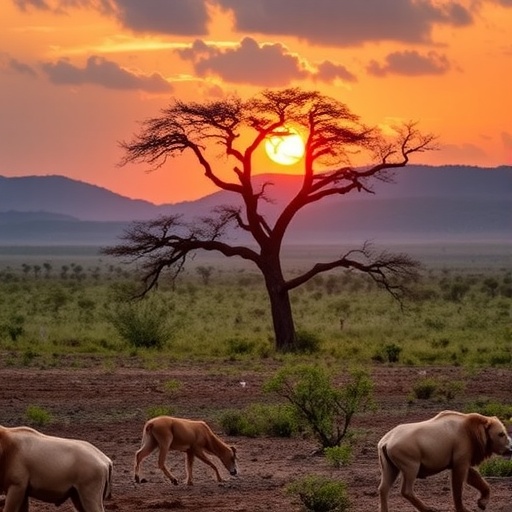Energy Flows Expose Africa’s Declining Animal Ecosystem – Bioengineer.org

Report on Animal-Driven Energy Flows and Ecosystem Function Decline in Africa
Introduction: An Energetics Approach to Assessing Ecosystem Health
A recent study provides a novel assessment of ecosystem health across Africa by analyzing energy flow through terrestrial mammal communities. This energetics framework serves as a critical tool for monitoring progress towards the United Nations Sustainable Development Goals (SDGs), particularly SDG 15 (Life on Land). By quantifying the decline in animal-driven ecosystem functions, the research highlights the urgent need for enhanced conservation and restoration strategies to halt biodiversity loss and ecosystem degradation.
Key Findings and Methodological Considerations
The research integrates diverse datasets to model energy consumption by animal guilds, offering a dynamic measure of ecosystem function that complements traditional biodiversity metrics. Key findings include:
- Decline in Functional Integrity: The study reveals significant declines in animal-driven ecosystem functions continent-wide, linking these trends to species loss and land-use changes. This directly impacts the targets of SDG 15, which aim to protect and restore terrestrial ecosystems.
- Energy Flow vs. Stability: High energy throughput by a single dominant species can indicate ecological vulnerability, not resilience. This underscores the importance of species diversity within functional roles for maintaining stable ecosystems, a core principle for achieving long-term environmental sustainability under SDG 13 (Climate Action) and SDG 15.
- Nuanced Impacts of Human Activity: Certain land-use practices, such as selective logging or specific agricultural methods, can locally increase animal energy consumption. This finding challenges conventional conservation paradigms and calls for context-specific management strategies that align with SDG 12 (Responsible Consumption and Production).
- Methodological Caveats: The continental-scale model relies on data integration with inherent assumptions and uncertainties. The authors recommend guild-level analyses for more robust insights and call for complementary local-scale studies to refine the models.
Direct Implications for Sustainable Development Goal 15: Life on Land
The study’s findings are of paramount importance for evaluating and guiding actions related to SDG 15. The energy flow metric provides a quantifiable way to assess progress towards several key targets.
- Target 15.1: Conservation and Restoration of Terrestrial Ecosystems: The energetics framework allows for a more holistic evaluation of restoration success. Projects should aim not only to increase total energy throughput but also to ensure a diverse range of species contribute to ecosystem functions, thereby enhancing resilience.
- Target 15.5: Halting Biodiversity Loss: By framing biodiversity loss in terms of declining energetic vitality and functional collapse, the research provides a powerful argument for urgent action to protect threatened species and prevent further degradation of natural habitats.
- Target 15.9: Integrating Ecosystem Values into Planning: This research provides a methodology to integrate the functional value of ecosystems into national and local planning. Quantifying energy flows can help policymakers make informed decisions about land use that balance development needs with the imperative to maintain essential ecosystem services, which also supports SDG 2 (Zero Hunger) through functions like nutrient cycling.
Broader Linkages to the Global Sustainability Agenda
Beyond SDG 15, the report’s implications extend to other critical development goals:
- SDG 2 (Zero Hunger): The decline in animal-mediated functions such as pollination, seed dispersal, and nutrient cycling directly threatens the productivity and resilience of agricultural systems that millions depend on.
- SDG 13 (Climate Action): Healthy, biodiverse ecosystems are more resilient to climate change. The study’s focus on ecological stability is crucial for understanding how to manage landscapes to support both biodiversity and climate adaptation.
Conclusion and Recommendations for Policy
This research establishes energy flow analysis as an indispensable tool for diagnosing the health of terrestrial ecosystems in the context of the global biodiversity crisis. To advance the 2030 Agenda for Sustainable Development, it is recommended that:
- Conservation and restoration policies adopt a dual-metric approach, integrating both traditional species-based indicators and functional metrics like energy flow to achieve a more comprehensive assessment of ecosystem health.
- Land management strategies be re-evaluated to consider the nuanced impacts of human activities, promoting practices that can sustain or even enhance ecosystem functions in line with SDG 12.
- Further investment is made in data collection and modeling to refine continental-scale analyses and support evidence-based policymaking aimed at achieving SDG 15 and related environmental targets.
Analysis of Sustainable Development Goals in the Article
1. Which SDGs are addressed or connected to the issues highlighted in the article?
-
SDG 15: Life on Land
- The article is fundamentally centered on SDG 15, which aims to protect, restore, and promote the sustainable use of terrestrial ecosystems, sustainably manage forests, combat desertification, and halt and reverse land degradation and biodiversity loss. The research discussed directly addresses these issues by assessing “declining animal-driven ecosystem functions across Africa,” which is a core component of terrestrial ecosystem health. The study analyzes the impacts of “species losses and land use changes” on “biodiversity integrity and ecosystem health,” aligning perfectly with the objectives of SDG 15.
2. What specific targets under those SDGs can be identified based on the article’s content?
-
Target 15.1: Ensure the conservation, restoration and sustainable use of terrestrial and inland freshwater ecosystems and their services.
- The article directly relates to this target by providing a new framework to assess ecosystem health and guide “restoration and conservation efforts.” It evaluates how “animal-driven ecosystem functions” are declining, which are essential ecosystem services. The study’s goal is to offer a “crucial tool for guiding restoration” by assessing recovery trajectories in a more holistic way.
-
Target 15.5: Take urgent and significant action to reduce the degradation of natural habitats, halt the loss of biodiversity and, by 2020, protect and prevent the extinction of threatened species.
- The article’s central theme is the “alarming declines in animal-driven ecosystem functions” resulting from biodiversity loss. It highlights how “species losses and land use changes ripple through ecological networks” and frames its findings as an “urgent call to action in the context of the ongoing biodiversity crisis.” By measuring the functional consequences of declining animal populations, the study provides a method to quantify the urgency and scale of biodiversity loss, directly supporting the call to action in this target.
-
Target 15.9: Integrate ecosystem and biodiversity values into national and local planning, development processes, poverty reduction strategies and accounts.
- The research proposes a new methodological approach—using “energy flow metrics”—to better understand and value ecosystem functions. The article states that this framing has the “potential to galvanize broader support and inform policy frameworks worldwide.” By offering a quantitative tool to evaluate ecosystem health and the effects of different land management strategies, the study provides a mechanism for integrating these ecological values into planning and policy-making, as called for by this target.
3. Are there any indicators mentioned or implied in the article that can be used to measure progress towards the identified targets?
-
Energy Flow Metrics
- This is the primary indicator proposed by the study. The article presents “energy flow through animal communities” as a “vital proxy for understanding ecosystem function.” Unlike traditional metrics, it “embodies the dynamic processes through which species interact with their environment.” This indicator can be used to measure the functional integrity of ecosystems (Target 15.1) and the functional consequences of biodiversity loss (Target 15.5).
-
Diversity of Species Contributing to Ecosystem Functions
- The article implies this as a crucial complementary indicator. It cautions that high energy flow alone is not sufficient and that “a multiplicity of contributors is essential for buffering ecological functions.” When assessing restoration, the study advises evaluating “not just the magnitude of recovered energy throughput but also the diversity of species contributing to key ecosystem functions.” This provides a more nuanced measure of ecosystem resilience and health.
-
Traditional Biodiversity Metrics (for comparison)
- The article mentions traditional indicators to highlight the novelty of its approach. These include “species counts or presence,” “species richness and abundance,” and “biodiversity intactness indices.” While the study argues these are insufficient on their own, they are established indicators relevant to measuring biodiversity (Target 15.5) and are used as data inputs for the new energy flow models.
4. Summary Table of SDGs, Targets, and Indicators
| SDGs | Targets | Indicators |
|---|---|---|
| SDG 15: Life on Land | Target 15.1: Ensure the conservation, restoration and sustainable use of terrestrial and inland freshwater ecosystems and their services. |
|
| SDG 15: Life on Land | Target 15.5: Take urgent and significant action to reduce the degradation of natural habitats and halt the loss of biodiversity. |
|
| SDG 15: Life on Land | Target 15.9: Integrate ecosystem and biodiversity values into national and local planning and development processes. |
|
Source: bioengineer.org
What is Your Reaction?
 Like
0
Like
0
 Dislike
0
Dislike
0
 Love
0
Love
0
 Funny
0
Funny
0
 Angry
0
Angry
0
 Sad
0
Sad
0
 Wow
0
Wow
0



















































.jpg.webp?itok=0ZsAnae9#)


























